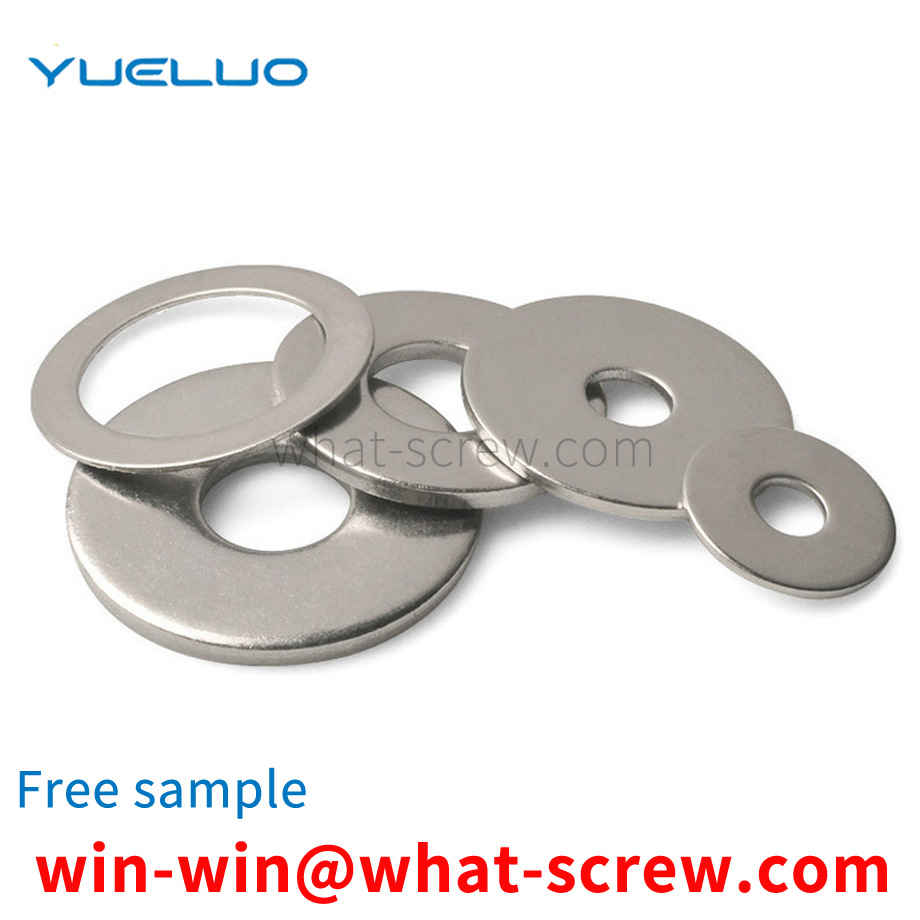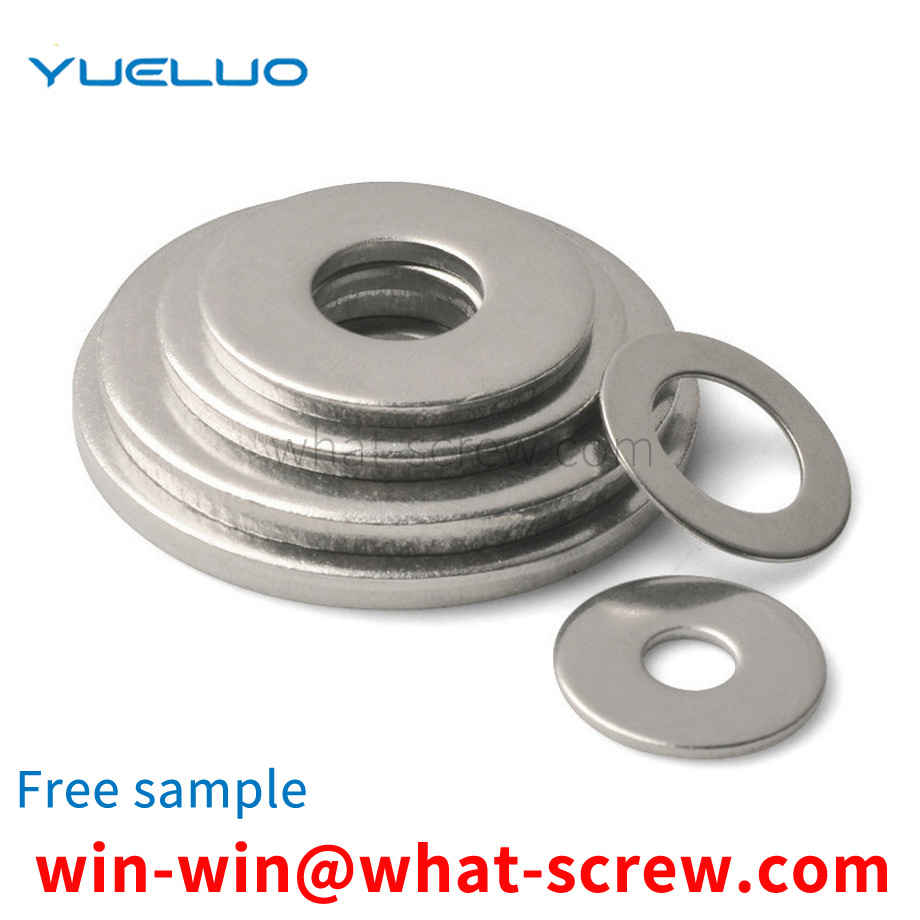Countersunk head screws are mostly used after installation, and the surface of the parts cannot be raised, and the parts to be fastened have two thicknesses. Thickness, after the screw is tightened, there is still a part of the screw thread that does not enter the threaded hole. In this case, the countersunk head screw can definitely be tightened. There is usually a situation where the thickness of the fastened part is less than the height of the head of the countersunk head screw, which is commonly seen in sheet metal parts in mechanical equipment, such as the connection between the hinge of the chassis and the door and the box; the sheet metal of the equipment The connection of the cover to the equipment, etc. Due to the small thickness of the part, the tightened sheet metal part, the screw through hole completely becomes a conical hole, in this case, when the countersunk head screw is tightened, the screw head is not a tapered surface to press the sheet metal part , but the bottom of the screw head and the top of the threaded hole are squeezed. Although it feels that the screw is tightened, the sheet metal part is stuck instead of being pressed. In this case, although it feels that the screw is tightened, the sheet metal The gold pieces were indeed not tightened. This is a very common situation. Let’s talk about the reasons for the processing: the head cone of the countersunk screw has a 90° conical angle, and the apex angle of the newly bought drill is usually 118°-120°. Some workers who lack training do not know this angle is poor. It is often used to ream the hole with a 120° drill bit, which results in that when the countersunk head screw is tightened, it is not the conical surface of the head, but a line at the bottom of the screw head, which is one of the reasons why the so-called countersunk head screw cannot be tightened. , it's not the screw's fault.
The connecting fasteners of the existing panel furniture are generally composed of pins, screws and nuts. When connecting two furniture boards, a nut must be placed in the hole first, then the screw is tightened, and then the pin is connected, which is not very convenient to assemble. Wood screws are generally used for fixing the existing concealed hinges, and the positioning is inaccurate, the installation is laborious and time-consuming, the labor intensity is high, and the work efficiency is low.
1. Material strain hardening When the material is cyclically loaded, the phenomenon of cyclic strain hardening or cyclic strain softening will occur, that is, under the condition of constant cyclic strain, the stress amplitude will increase or decrease with the increase of the number of cycles. . After several cycles, the stress amplitude enters a cyclic steady state. The low-cycle fatigue of the lock nut is carried out under the condition that the strain is constant, and the strain hardening or softening of the threaded piece will affect the size of its maximum unscrewing torque. The alloy steel used to make the lock nut is a cyclic strain hardening material, and the hardening of the material will increase the elastic restoring force FN of the threaded sheet and increase the unscrewing torque.
GB/T3103.3-2000 Fastener Tolerance Flat Washers 2 GB/T5286-2001 General Scheme of Flat Washers for Bolts, Screws and Nuts 3 GB/T9074.1-2002 Bolts or Screws and Flat Washers Assemblies 4 GB/T9074. 18-2002 Self-tapping screws and flat washers assemblies 5 GB/T 95-2002 Flat washers C grade 6 GB/T96.1-2002 Large washers A grade 7 GB/T96.2-2002 Large washers C grade 8 GB/T97. 1-2002 Flat washer Class A 9 GB/T97.2-2002 Flat washer chamfered Class A 10 GB/T97.4-2002 Flat washer for screw and washer assemblies 11 GB/T97.5-2002 Flat washer Self-tapping screws and washers assemblies 12 GB/T848-2002 Small washers Class A 13 GB/T5287-2002 Extra large washers Class C 14 GB/T4678.13-2003 Die-casting mold parts Part 13: Push plate washers 15 GB/T4605 -2003 Rolling bearing thrust needle roller and cage assemblies and thrust washers 16 GB/T97.3-2000 Flat washers for pins 17 GB/T18230.5-2000 Flat washers for bolted structures quenched and tempered 18 GB/T9074.5 -2004 Cross recessed small pan head screw and flat washer assembly 19 GB/T9074.20-2004 Cross recessed hexagon head tapping screw and flat washer assembly 20 GB/T3762-1983 Sharp angle sealing washer for ferrule type pipe joint 21 GB/T1231-2006 Specifications for high-strength large hexagon head bolts, large hexagon nuts and washers for steel structures 24 GB/T5649-2008 Lock nuts and washers for pipe joints and washers 27 GB/T10447-2008 Elements and tolerances of semicircular thrust washers for sliding bearings 28 GB/T94.1-2008 Specifications for elastic washers Spring washers 29 GB/T10446-2008 Dimensions and tolerances for full circle thrust washers for sliding bearings 30 GB/ T93-1987 standard spring washer 31 GB/T94.2-1987 elastic washer technical conditions toothed, serrated lock washer 32 GB/T98-1988 stop washer technical conditions 33 GB/T849-1988 spherical washer 34 GB/T850- 1988 Conical Washer 35 GB/T851-1988 Split Washer 36 GB/T852 -1988 Square bevel washer for I-beam 37 GB/T853-1988 Square bevel washer for channel steel 38 GB/T854-1988 Single-ear stop washer 39 GB/T7244-1987 Heavy-duty spring washer 40 GB/T855-1988 Double-ear stop Dynamic washer 41 GB/T7245-1987 Saddle spring washer 42 GB/T7246-1987 Wave spring washer 43 GB/T856-1988 Outer tongue stop washer 44 GB/T858-1988 Stop washer for round nut 45 GB/T859-1987 Light spring washer 46 GB/T860-1987 Saddle elastic washer 47 GB/T861.1-1987 Internal tooth lock washer 48 GB/T861.2-1987 Internal serrated lock washer 49 GB/T862.1-1987 External tooth lock 50 GB/T862.2-1987 External Serrated Lock Washers 51 GB/T955-1987 Wave Elastic Washers 52 GB/T27938-2011 Sliding Bearing Thrust Washers Failure Damage Terms, Appearance Features and Reasons 53 GB/T956.1- 1987 Conical lock washer 54 GB/T956.2-1987 Conical serrated lock washer 55 GB/T28697-2012 Rolling bearing self-aligning thrust ball bearing and self-aligning seat washer Dimensions 56 GB/T9074.2-1988 Cross groove disc Head screw and male serrated lock washer assembly 57 GB/T9074.3-1988 Cross recessed pan head screw and spring washer assembly 58 GB/T9074.4-1988 Cross recessed pan head screw, spring washer and flat washer assembly 59 GB /T9074.7-1988 Cross recessed small pan head screw and spring washer assembly 60 GB/T9074.8-1988 Cross recessed small pan head screw and spring washer and flat washer assembly 61 GB/T9074.9-1988 Cross recessed countersunk Head screw and conical lock washer assembly 62 GB/T9074.10-1988 Cross recessed countersunk head screw and conical lock washer assembly 63 GB/T9074.11-1988 Cross recessed hexagon head bolt and flat washer assembly Parts 64 GB/T9074.12-1988 Cross recessed hexagon head bolt and spring washer assembly 65 GB/T9074.13-1988 Cross recessed hexagon head bolt, spring washer and flat washer assembly 66 GB/T9074.15- 1988 Hexagon head bolt and spring washer assembly 67 GB/T9074.16-1988 Hexagon head bolt and serrated lock washer assembly 68 GB/T9074.17-1988 Hexagon head bolt, spring washer and flat washer assembly 69 GB/T9074 .26-1988 Spring Washers for Assemblies 70 GB/T9074.27-1988 External Serrated Lock Washers for Assemblies 71 GB/T9074.28-1988 Conical Lock Washers for Assemblies 72 GB/T1030-1988 Inner Spherical Washers[1]
At present, with the development of the manufacturing industry, many parts with strange shapes are widely used in aviation, aerospace and other industrial fields, one of which is an L-shaped cylindrical pin. The upper end is provided with a 2.55×4.95 U-shaped boss. The parallelism error between the upper end face and the lower end face of the boss is required to be less than 0.01 mm. The L-shaped cylindrical pin requires high machining accuracy and is difficult to clamp on the machine tool. It is difficult to process. When the forming part is cut off, the cut surface, that is, the upper end surface of the boss, will leave a small column platform. When processing this end surface, in the prior art, a vise is generally used to process such an L-shaped cylindrical pin. Or copper sleeves are clamped, and then processed; however, due to the small size of the parts, the L-shaped cylindrical pin workpiece is difficult to clamp; due to the high precision required for each machined surface of the workpiece, when clamping with a vise , the clamping force of the vise is difficult to control, and it is easy to crush and scratch the surface of the workpiece; and when using a vise or a copper set clamp, only one workpiece can be clamped for each processing and production, and it is difficult to ensure the upper and lower planes of the parts after the clamping is completed. Parallelism machining error, resulting in low parts processing quality and low production efficiency.
We have many years of experience in the production and sales of screws, nuts, flat washers, etc. The main products are: wire machine teeth PM electronic small screws, DIN1440, special long hexagon socket screws, pull cap flat head column nuts and other products, we can provide you with suitable products for you fastener solutions.



















 Service Hotline
Service Hotline




